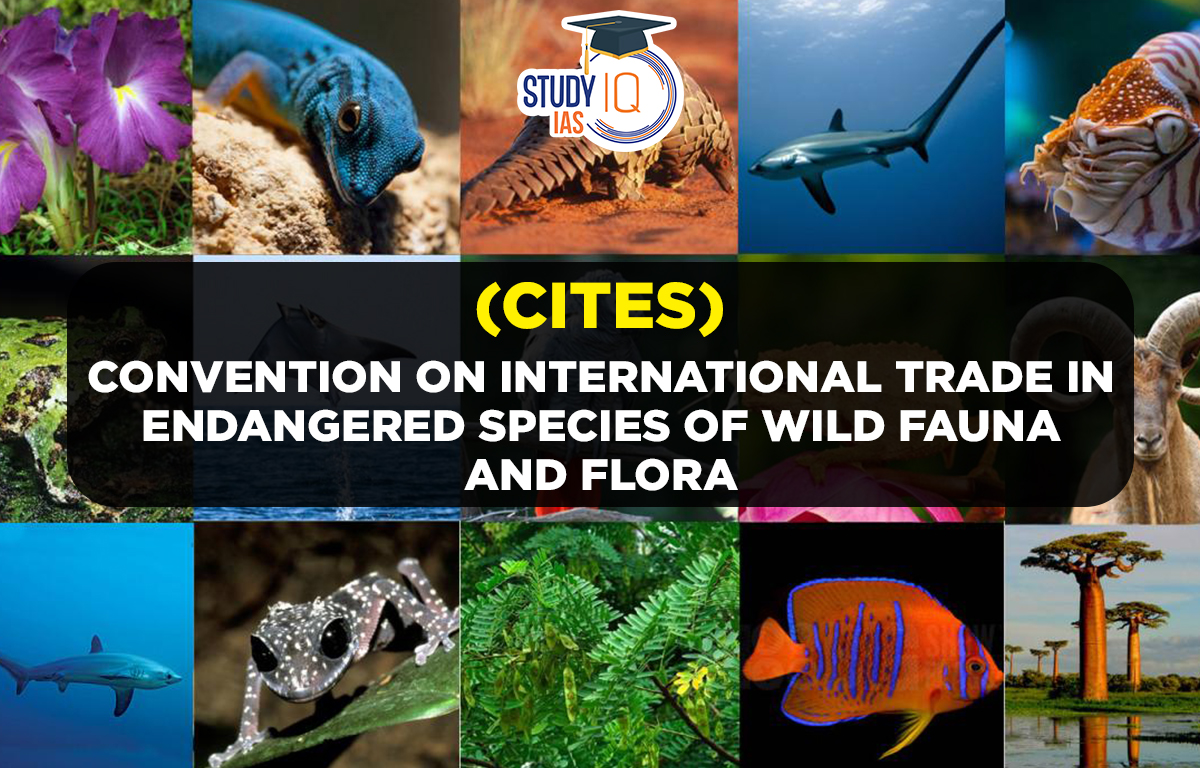Table of Contents
Context: March 3, 2023, World Wildlife Day marks the 50th anniversary of the Convention on International Trade in Endangered Species of Wild Fauna and Flora (CITES) in 1973.
World Wildlife Day
- In 2013, the United Nations General Assembly (UNGA) proclaimed March 3 as the UN World Wildlife Day to celebrate and raise awareness of protecting the world’s wild animals and plants.
- This was as the Convention on International Trade in Endangered Species of Wild Fauna and Flora (CITES) was signed in 1973 on this day.
- CITES is considered a landmark agreement on conservation that focuses on ensuring the sustainability of endangered species.
About CITES (Convention on International Trade in Endangered Species of Wild Fauna and Flora)
- It is an international agreement between governments to ensure that international trade in specimens of wild animals and plants does not threaten their survival.
- Establishment: CITES was drafted as a result of a resolution adopted in 1963 at a meeting of members of IUCN (World Conservation Union).
- Text of Convention was finally agreed in Washington in 1973 and entered into force in 1975.
- Headquarters: The CITES secretariat is administered by United Nations Environment Programme (UNEP) and is located at Geneva, Switzerland.
- Members: There are currently 184 parties (including India) to the Convention.
- All 184 Parties to CITES have right to attend, to put forward proposals to consider, and to vote on all decisions.
- Nature of the convention: Although CITES is legally binding on the Parties, it does not take the place of national laws. Rather it provides a framework to be respected by each Party, which has to adopt its own domestic legislation to ensure that CITES is implemented at the national level.
- How does CITES work? The species covered by CITES are listed in three Appendices, according to the degree of protection they need (Refer infographic).

India and CITES
- Extensive use of Appendix III: Since its ratification of CITES in 1976, India has listed 39 taxa in Appendix III.
- Through the listings, important international trade data was gathered that supported decision for application to a different CITES Appendix (with stricter trade controls).
- The Director of Wildlife Preservation, Government of India has been designated responsibility as the Management Authority for CITES (CITES-MA) in India.
- In addition, Government of India has also appointed five Scientific Authorities which assist the CITES MA on scientific aspects of CITES. These are:
- Zoological Survey of India (ZSI), Kolkata.
- Botanical Survey of India (BSI), Kolkata.
- Central Marine Fisheries Research Institute (CMFRI), Cochin.
- Wildlife Institute of India (WII), Dehradun.
- Institute of Forest Genetics and Tree Breeding (IFGTB), Coimbatore.
- International trade in all wildlife species of India, including the species covered under CITES in particular, is regulated collectively through the provisions of the
- Wild Life (Protection) Act of 1972,
- Export–Import Policy (EXIM Policy) under the Foreign Trade (Development and Regulation) Act of 1992 and
- Customs Act of 1962.
Limitations of CITES
- Structural gap limiting the effectiveness of CITES: The Convention is a trade agreement and only applies to flora and fauna that is traded internationally.
- CITES has no application to domestic markets and wildlife trafficking occurring intra-state. This is left to the respective governments.
- Issues with the listing: CITES’ application is restricted by its appendix listing system. Species not listed in an appendix are afforded no protection by the Convention.
- For example, only about 8 percent of world’s known reptile species are listed. This is despite reported trade in the skins of many non-listed reptiles.
- Political nature of negotiations: CITES is a consensus-orientated body but can take decisions by two-thirds majority when required.
- During the lifetime of CITES, 84 species were moved from Appendix I to Appendix II. It means that parties could accept a relaxation of the degree of protection.
- Inadequate attention to welfare of animals: CITES system does not devote great consideration to the welfare of animals traded pursuant to its provisions.
- Welfare of animals relates to his health, comfortable, well-nourished, safe, able to express innate behaviour.
- CITES reservation weakening system: States Parties may enter reservations to certain species being included in an Appendix, where the Party finds the listing of the species unacceptable.
- This is usually due to reserving party having a legitimate economic or trading interest in the species.
- Notable examples include reservation of Japan, Norway, and Iceland with regard to certain species of whale.
- Where a reservation is entered, the party is treated as being a non-party State by other States Parties with regard to trade in the species.


 List of Governor of States in India, Con...
List of Governor of States in India, Con...
 Daily Quiz 15 July 2025
Daily Quiz 15 July 2025
 Maratha Military Landscapes of India Add...
Maratha Military Landscapes of India Add...





















